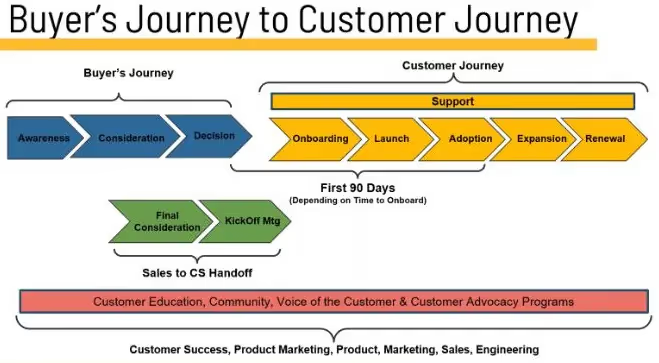A well-built customer journey spurs user adoption by helping customers accelerate their time to value and avoiding situations where they feel stranded.
In this Deep Dives session, Jan Young, Senior Consultant with The Success League, joined Srikrishnan Ganesan of Rocketlane to discuss how you can use your customer onboarding and adoption journey to minimize uncertainty and maximize the odds of reaching your customer success goals.
Jan Young, a Gain Grow Retain board member, Top 50 CS Influencer, and Top 50 Women Leaders in CS, works as a Senior Consultant with The Success League, a Customer Success consulting firm that works with executives to build and develop top-performing CS teams.
They offer customized CSM and Leadership Training, Customer Success Program Assessments, Interim Leadership Services, and Consulting Services. Since 2015, they have helped hundreds of companies improve their customer experience, and thousands of CS professionals build their careers.
In this session, Jan spoke about:
- The need to look at the customer’s journey from buyer to customer
- Keys to onboarding and adoption
- Keys to onboarding and adoption journeys
- Implementing effective onboarding and adoption journeys
Here are our key takeaways from the session.
1. Zoom out to look at the buyer-to-customer journey

Remember that a customer’s journey, as they perceive it, begins much before the sale – sometimes even 12 months before it. Anything that happens in the journey before onboarding can impact your customer’s expectations and, therefore, you. And this makes the transition that happens during Sales to CS handoff extremely critical.
2. Keys to onboarding and adoption
Before you dive into onboarding customers, here are some basics you need to cover first.
Customer base segmentation
Look beyond what the customer means to your business (the size/revenues of the company) to think about the customer, and their goals and behavior. Here are a few guiding questions:
- What are the customer’s goals?
- Why exactly did they buy the product?
- What do they consider success?
- What is their level of comfort with using technology?
Understand the limitations that economic and resource constraints pose.
- Do you need digital or human delivery? Assess if your product is complex enough to need human involvement.
- Can/should you charge for the human effort? Think about your personpower availability, or if you’d need to bring in additional resources (like Professional Services) for it.
These questions can help design the customer journey, and the ‘success’ events your onboarding and adoption journey should have.
If your customer base is too small to segment, ask them these questions, and then observe, analyze, and validate the answers for the future.
The best time to start segmenting: When you observe that your internal team is more organized, with an organic sense of specialization within the team, or when you start realizing that customers have different goals and behaviors – whichever happens first.
Determining the ideal customer journey
Here are a few questions that can help you identify the right customer journey for different customer segments.
Product and setup complexity
- How complex is your product?
- How complex is the setup? Assess if you need implementation (working with tech and getting things ready for product usage) or onboarding (working with people) or both.
Service delivery
- How tech-savvy is your customer segment? If they are tech-savvy, your focus needs to be on motivation and developing a sense of urgency, but in the case of non-technical customers, it could mean bringing in PS and charging the customer for their time.
- How does your customer want services to be delivered? Consider the level of one-on-one support they need. Identify approaches or alternatives to offer this to customers (Office Hour sessions, webinars, etc.)
- What is the capacity of your customer personas for onboarding?
- What is the capacity of your customer personas for product usage? Employees, on average, use 32 products in a day. Think about where your product fits in their business and what they can get done using your product.
Value realization
- What is the first value customers achieve?
- When in the customer journey and timeline does this happen? Think about what you can do to let customers know the progress they are making and how you can you acknowledge and celebrate it.
3. Keys to the onboarding journey
To map out the onboarding process and timeline, here’s what you need to consider, at the very least:
- Definitions (Onboarding, Activation, Launch, Training). Ensure that you have consistent definitions of the above – across all your CSMs.
- A high-level map with details and dependencies at the customer end; Customer expectation and communication
- Internal steps, stakeholders, and responsibilities; External steps, stakeholders, and responsibilities; ensure that you take into account all major stakeholders, even third-party involvement at the customer’s end (as partners, implementors, etc), and how you can coordinate with all of them.
- Potential challenges and delays
- Tracking, milestones, and celebrations. Make sure customers (including exec-level stakeholders) periodically know where they are, and their current status (on-track or off-track)
- Materials (for activities, tracking, training, etc)
4. Keys to the adoption journey
As you look at designing an effective adoption journey, here are a few questions to consider:
What does successful behavior look like and its key indicators?
- Make the customer create a success plan at kickoff. This could simply be a document containing a list of goals, with quantitative measures and timelines, or a one-pager with original purchase reasons, and SMART goals over the first 3-6 months.
- Identify and validate the key indicators of success. For example, ‘successful customers reach X milestone by Y time’.
What are the key milestones and goals for adoption for each segment?
- Set goals at kickoff and track them to milestones; tie every step to that goal and communicate progress periodically. Collect and share examples of each segment and demonstrate how similar customers have reached their goals.
- Track and communicate a customer’s progress as their adoption journey progresses.
What are some ways to engage and drive customers towards improved adoption?
After you identify how customers are doing based on the success plan initially conceive for them, here’s how you can steer, guide, or propel them further.
- Successful customers: Offer ways to excel, and highlight achievements.
- At-risk customers: Offer ways to course-correct and get back on track.
- Mid-level customers: Offer ways to improve their journey and the benefits of doing so.
Be explicit about when you deliver value or hit milestones. Call attention to when they have achieved something, or when you share practical tips or best practices.
5. Additional activities for onboarding and adoption
Customer education
- Know the different customer personas, their roles, and responsibilities
- Identify the key points where customer education can help (within individual stages like Onboarding, Launch, Adoption, and Support)
- Make space and time for repetition and reinforcement in your customer education initiatives.
- Ensure that you stagger your customer education initiatives, using a drip training/education approach.
- Make way for users to learn while and by, doing. Leverage in-app guides and tooltips for common queries.
Change management
- Eventually, organizational change management boils down to individual change. It’s important to take into account the emotional (getting users excited, say via a promo video) and psychological aspects of change management.
- Frameworks like the ADKAR (Awareness, Desire, Knowledge, Ability, Reinforcement) model can help make this happen.
- Change management is an ongoing exercise. Think about different focus areas for different stages. For example, Year 2 looks very different from Year 1 for the same customer.
Customer advocacy
Use opportunities to convert customers into champions. For instance, you could celebrate a customer who completed onboarding on time and highlight the organizational leadership or initiatives that enabled this. Pro tip: Position any instance where the customer overcame a challenge, or crossed a hurdle, as a joint achievement.















